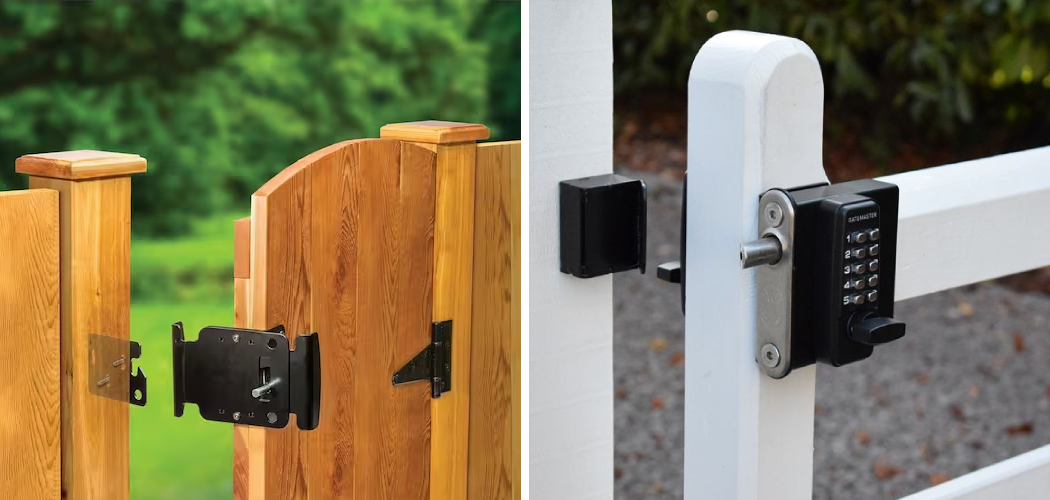Securing a fence gate is essential for maintaining privacy and ensuring safety. Knowing how to lock a fence gate from both sides can be particularly useful in various scenarios. For instance, in shared pathways connecting multiple properties, a lockable gate from both sides can prevent unauthorized access while allowing convenient and controlled entry.

Such measures are crucial in high-security areas to safeguard against trespassers and protect valuable assets. Several methods are available for locking a fence gate from both sides, each catering to different needs and circumstances. These include double-sided key locks, slide bolts with padlocks, and combination locks. By understanding how to lock a fence gate from both sides, you can choose the most suitable option to enhance security and ease of access for your specific situation.
Choosing the Right Locking Mechanism
Selecting the appropriate locking mechanism is crucial when determining how to lock a fence gate from both sides. Different solutions cater to various needs, balancing security, convenience, and installation complexity.
A double-sided key lock requires a key for access on both sides, making it a robust option for those prioritizing security. This type often includes an easily replaceable lock cylinder, allowing for long-term use and straightforward maintenance.
Another effective solution is a slide bolt with a padlock. This straightforward mechanism involves a bolt that slides into a catch, secured by a padlock. It can be locked from either side, offering versatility and effectiveness without needing a key, provided the padlock is suitably robust.
For those seeking keyless convenience, a combination lock is a compelling choice. These locks can be programmed with a numerical code, eliminating the need to carry and manage keys. This makes them especially useful in shared access situations or for individuals who prefer a simpler, keyless operation.
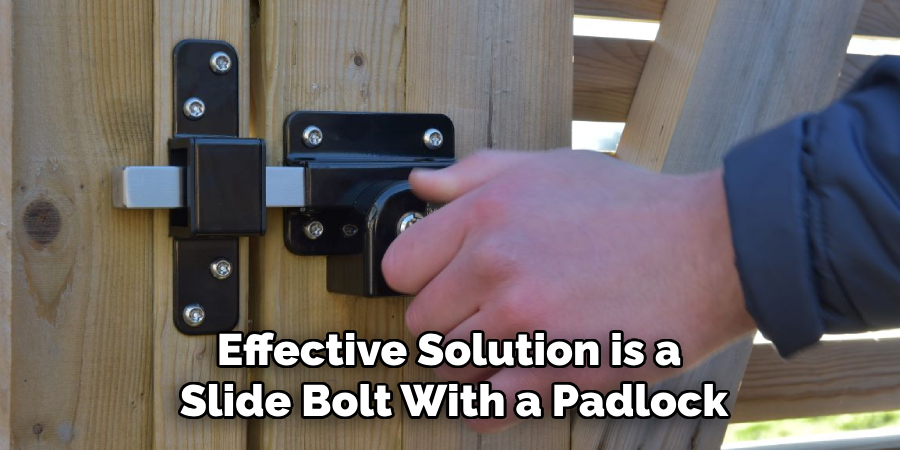
When choosing the right locking mechanism, several factors must be considered. The material and type of gate—whether wood, metal, or vinyl—will impact the compatibility and installation process. The level of security required is also critical; residential properties may differ significantly from high-security areas in terms of their needs. Lastly, ease of use and installation can influence the locking mechanism’s practical application, ensuring it meets your specific requirements effectively.
Tools and Materials Needed
List of Tools:
- Screwdriver
- Drill
- Measuring tape
- Pencil
- Level
List of Materials:
- Chosen locking mechanism (double-sided key lock, slide bolt, padlock, combination lock)
- Mounting hardware
How to Lock a Fence Gate from Both Sides: Installing a Double-Sided Key Lock
A double-sided key lock offers high security by requiring a key for access from both sides of the gate. Here, we provide a step-by-step guide to installing this type of lock.
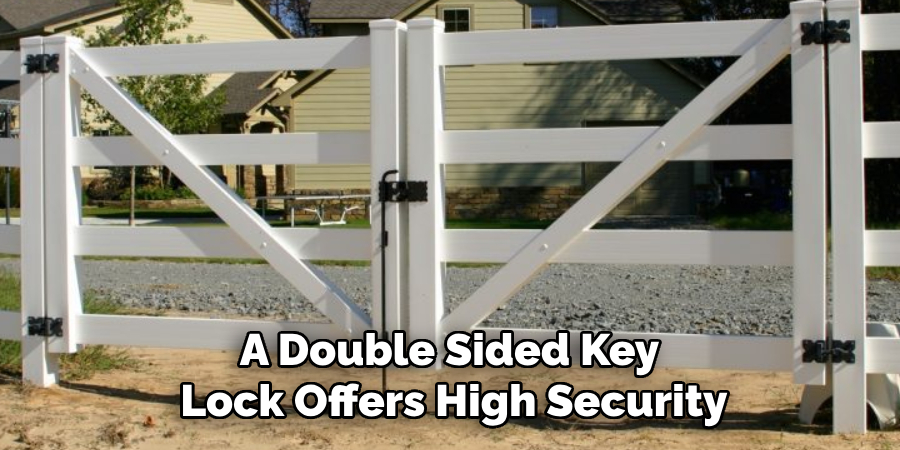
Measuring and Marking the Position for the Lock
Begin by deciding the ideal height for the lock on the gate and post, usually around waist height. Use a measuring tape to determine this height and make a precise mark with a pencil on the gate for the lock cylinder and on the post for the strike plate.
Drilling Holes for the Lock Cylinder and Mounting Screws
Using the marked points as a guide, drill holes in the gate for the lock cylinder, ensuring the hole is the correct diameter for the lock you are installing. Next, drill smaller pilot holes for the mounting screws around the lock cylinder hole to secure the lock body in place.
Inserting the Lock Cylinder and Securing it with Screws
Insert the lock cylinder into the drilled hole on the gate, ensuring it fits snugly. Use a screwdriver to secure the lock cylinder with the mounting screws. Ensure the lock cylinder is flush against the gate surface and tightly secured.
Installing the Strike Plate on the Gate Post
Align the strike plate with the lock cylinder on the gate, ensuring it is level and correctly positioned to receive the lock bolt. Mark the position of the screw holes and drill pilot holes. Attach the strike plate to the gate post using the provided screws and a screwdriver.
Testing the Lock to Ensure Smooth Operation from Both Sides
With the lock cylinder and strike plate securely installed, test the lock by turning the key on both sides. Ensure the bolt smoothly enters the strike plate without obstruction. Make any necessary adjustments to align the lock properly.
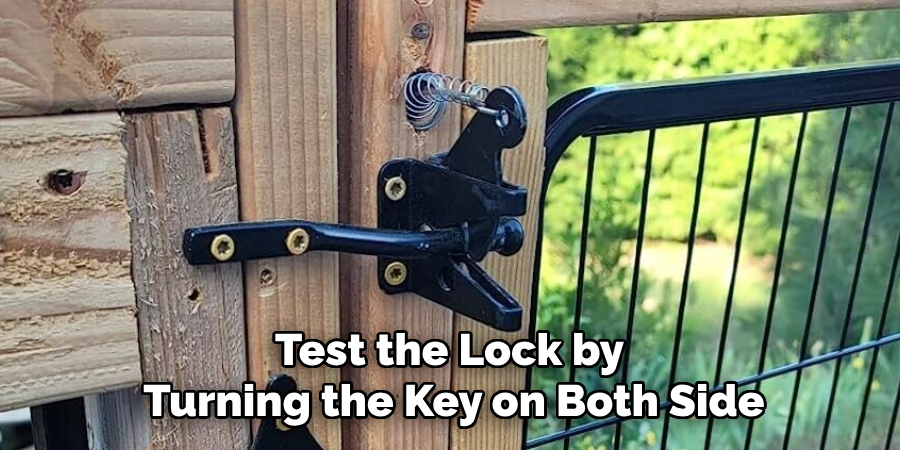
By following these steps, you can successfully install a double-sided key lock, providing enhanced security for your fence gate.
How to Lock a Fence Gate from Both Sides: Installing a Combination Lock
A combination lock provides keyless entry and is an excellent option for those seeking convenience and security. Here’s a step-by-step guide to installing a combination lock on a fence gate.
Choosing a Combination Lock Compatible with the Gate Material
Select a combination lock designed to work with your gate’s material, whether wood, metal, or vinyl. Ensure the lock features weather-resistant properties for long-lasting performance.
Measuring and Marking the Position of the Lock on the Gate and Post
Determine the desired height for the combination lock, typically around waist height. Use a measuring tape to mark the position of the lock body’s gate and the post for the catch. Use a pencil to mark precise points for drilling.
Drilling Holes for the Lock and Mounting Hardware
Drill holes correspond to the lock body and the catch at the marked points. Ensure the holes are of adequate diameter to accommodate the lock and mounting screws.
Securing the Combination Lock to the Gate with Screws
Place the combination lock on the gate at the drilled position. Use the provided screws to secure the lock to the gate. Ensure the lock is mounted firmly and at a level.
Programming the Combination and Testing the Lock from Both Sides
Follow the manufacturer’s instructions to set your unique combination code. Once programmed, test the lock from both sides of the gate to ensure it operates smoothly and the combination is accurately set.
Ensuring the Combination Lock is Easily Accessible and Functional
Confirm that the combination lock is easily accessible and user-friendly, with the code mechanism functioning correctly. If necessary, make any adjustments to align the lock for optimal performance.
By following these steps, you can install a combination lock that offers secure, keyless entry for your gate.
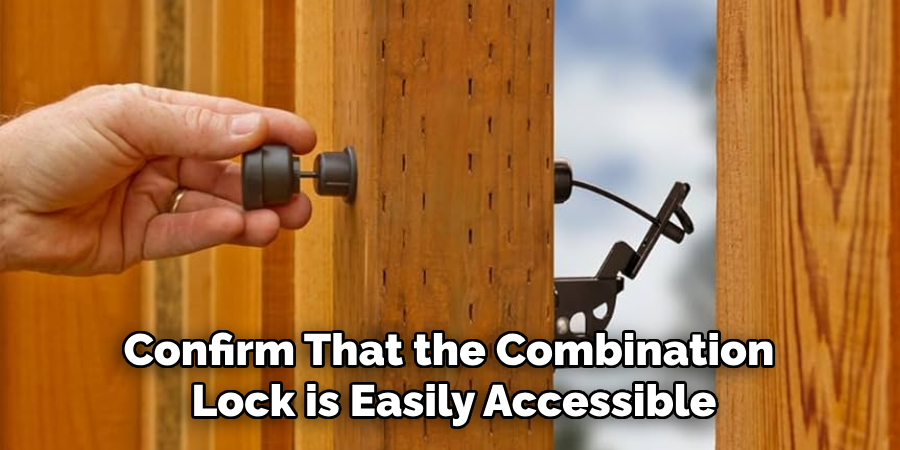
Additional Security Measures
Installing a Security Bar or Gate Brace
A security bar or gate brace can significantly enhance the security of your fence gate. Position the bar horizontally across the gate at a height that maximizes its strength and deterrence, typically mid-gate or at handle height.
Positioning the Bar Across the Gate for Added Security
Hold the bar in the desired position across the gate. Ensure it aligns evenly and spans the width of the gate, providing a sturdy barrier against forced entry.
Securing the Bar to the Gate and Post with Mounting Brackets
Using mounting brackets, attach the bar firmly to the gate and post. Ensure the brackets are made of high-strength material and are securely fastened with screws to support the bar.
Adding a Secondary Lock for Increased Security
Installing a Padlock or Chain in Addition to the Primary Lock
To bolster security further, install a secondary lock like a padlock or chain. Attach the padlock or chain to a fixed point on the gate and post, ensuring it complements the primary locking mechanism.
Ensuring All Locks Are Accessible and Easy to Use
Verify that all installed locks, including the security bar, are easily accessible and user-friendly. Regularly inspect them to ensure they function correctly and provide the intended level of security.
Regular Maintenance Tips
Importance of Regular Inspection and Maintenance of Gate Locks
Regular inspection and maintenance of your gate locks are crucial to ensure lasting security and functionality. Neglecting these tasks can lead to operational issues and reduce the overall effectiveness of your gate’s security systems.
Checking and Tightening Any Loose Screws or Bolts Periodically
Periodically inspect all screws and bolts on your gate locks. Tighten any that have become loose over time to prevent mechanical failure. This simple step can vastly improve the longevity and reliability of your locks.
Lubricating Locks and Moving Parts to Ensure Smooth Operation
Apply lubricant to the locks and any moving parts at regular intervals. Use a high-quality, weather-resistant lubricant to ensure the mechanisms operate smoothly and prevent rust and corrosion.
Cleaning Locks to Prevent Dirt and Debris Buildup
Clean your gate locks periodically to remove dirt, debris, and other contaminants. Use a mild cleaner and a soft cloth to maintain the lock’s exterior and interior parts, ensuring optimal performance.
Replacing Worn or Damaged Parts Promptly
If you notice any worn or damaged components during your inspections, replace them immediately. Prompt replacement of compromised parts will help maintain the security and functionality of your gate locks.
Troubleshooting Common Issues
Addressing Difficulty in Locking or Unlocking
If you encounter difficulties locking or unlocking your gate, check for proper alignment between the lock and the strike plate. Misalignment can prevent the lock from engaging smoothly.
Ensuring Proper Alignment of the Lock and Strike Plate
Inspect the position of the lock and strike plate. Adjust as needed to ensure they are properly aligned. This may involve moving the strike plate slightly up or down or repositioning the lock itself for a better fit.
Checking for Obstructions or Debris in the Lock Mechanism
Examine the lock mechanism for any obstructions or debris that could impede its function. Use compressed air or a soft brush to clean out any particles that may be causing issues.
Dealing with Weather-Related Issues
Weather conditions can affect the performance of your gate lock. Ensure you use weatherproof locks or protective covers to protect against rain, snow, and extreme temperatures.
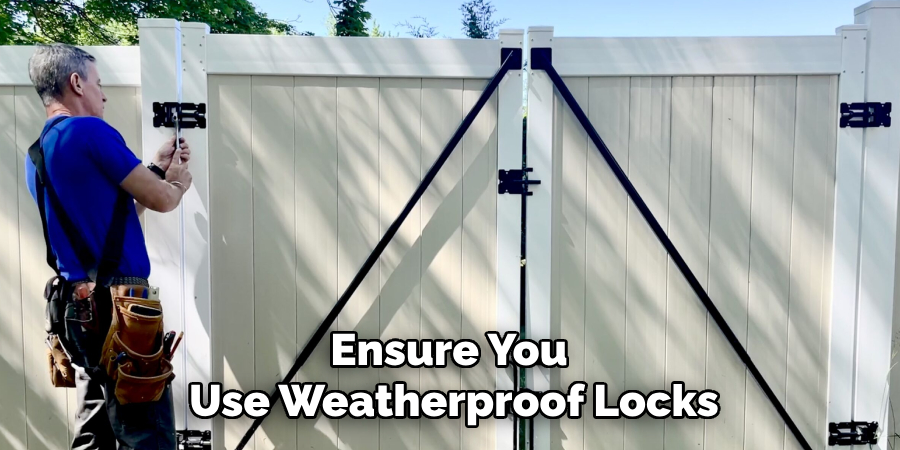
Applying Rust Inhibitor to Metal Locks and Parts
Apply a rust inhibitor regularly to metal locks and moving parts to prevent corrosion. This helps maintain the lock’s functionality and prolong its lifespan, especially in harsh weather conditions.
Conclusion
Securing a fence gate from both sides is paramount for maintaining a well-protected perimeter. It ensures that access is controlled and unauthorized entry is deterred. To achieve this, we have outlined comprehensive steps on how to lock a fence gate from both sides. Firstly, installing a combination lock offers keyless convenience and heightened security. Supplementary measures like a security bar or gate brace further strengthen the gate’s resistance to forced entry, while adding a secondary lock such as a padlock or chain provides an additional layer of security.
Regular maintenance is crucial; tighten loose screws, lubricate moving parts, clean the mechanisms, and promptly replace any worn components. By following these guidelines and maintaining a vigilant approach towards inspection and upkeep, you can ensure that your fence gate remains secure and functional, safeguarding your property effectively.

